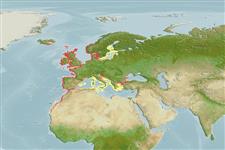Preferred temperature (Ref.
115969): 9 - 16.1, mean 10.8 (based on 450 cells).
Phylogenetic diversity index (Ref.
82804): PD
50 = 0.5001 [Uniqueness, from 0.5 = low to 2.0 = high].
Bayesian length-weight: a=0.00776 (0.00400 - 0.01507), b=3.08 (2.92 - 3.24), in cm Total Length, based on LWR estimates for this species & Genus-body shape (Ref.
93245).
栄養段階 (Ref.
69278): 3.3 ±0.3 se; based on diet studies.
回復力 (Ref.
120179): 手段, 1.4年~4.4年の倍増期間の最小個体群 (K=0.29; tm=0.8; tmax=2.6; Assuming fec < 10,000).
Fishing Vulnerability (Ref.
59153): Low to moderate vulnerability (33 of 100).
